In the time of the instagramworthy views and overcrowded hot spots, they still exist: the undiscovered places. One of them? The Sutjeska National Park. A wild paradise in the heart of the Balkans, in the east of Bosnia and Herzegovina on the border with Montenegro.
The karstic peak of Maglić, the highest mountain in Bosnia and Herzegovina, rises steeply into the sky, wild animals frolic in the lush meadows of Zelengora and one of the last primeval forests in Europe, the Perućica, not only hides an enchanted waterfall, but is also home to many animal species that have long been endangered in Europe.
In the national park Sutjeska we humans are still just guests, immersing ourselves in the silence and the well-rehearsed coexistence of nature, full of awe, with the feeling that we are actually quite small. Off the beaten track, you can still find unspoilt nature and beauty here, and even though many national parks claim this - it really is true here.
I was lucky enough to spend three days in the national park recently, exploring its most beautiful hiking trails and visiting its most impressive viewpoints. In this article, I will introduce you to the most beautiful hikes in Sutjeska National Park.
So let's go - to the Yosemite of the Balkansas it is sometimes called.
But a warning in advance: Afterwards, you'll definitely want to lace up your hiking boots straight away!
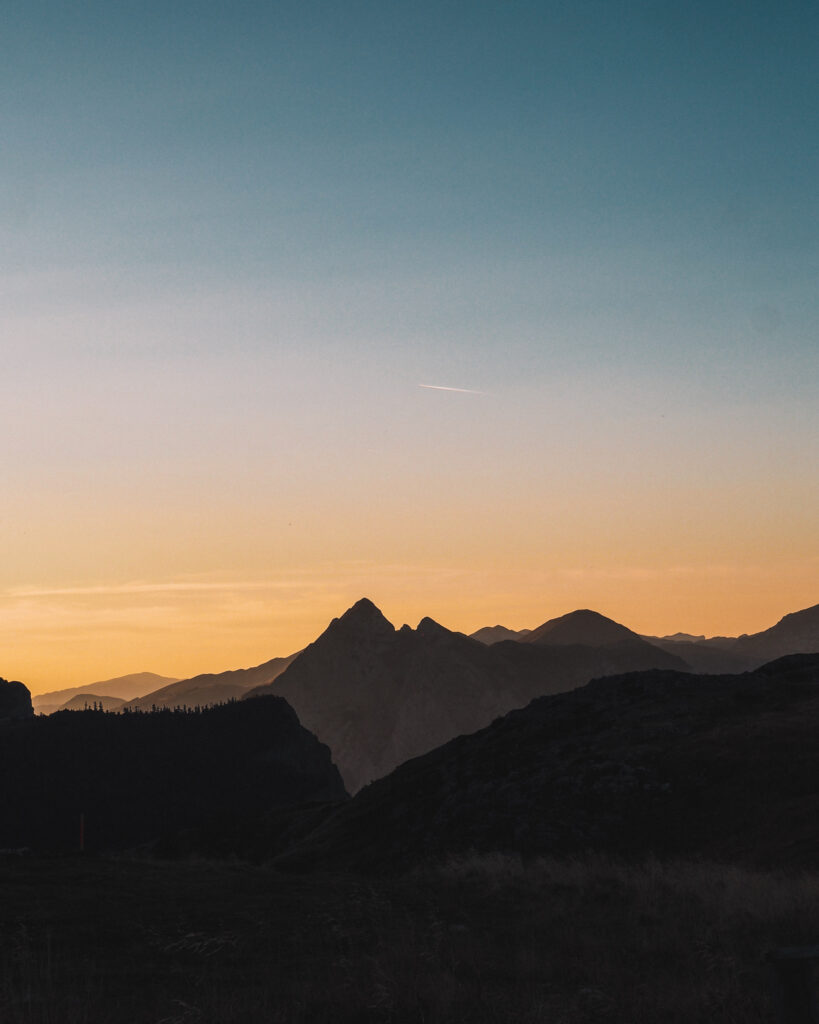
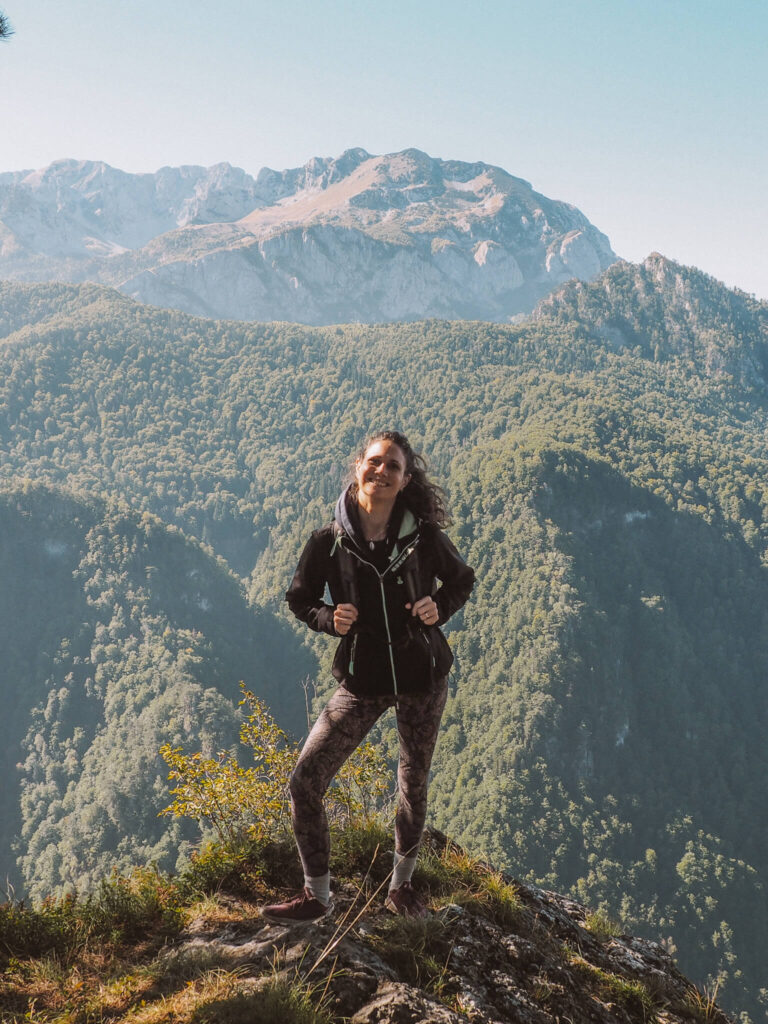
The oldest national park in Bosnia and Herzegovina
Sutjeska National Park in Bosnia and Herzegovina is not only the largest, but also the oldest national park in the country. It was founded in 1962 and even in the 1950s, before the park was actually established, part of its current area, namely the Perućica primeval forest, was declared a protected zone.
Sometimes also the Yosemite of the Balkans the Sutjeska National Park is home to the Maglićthe highest peak in the country at 2,386 metres, one of the last primeval forests in Europe, Perućica and many endemic animal and plant species. The rugged, karstic mountains are home to trees over 300 years old, lush meadows, crystal-clear mountain lakes, deep gorges and waterfalls.
Sutjeska is also part of the Via Dinarica, a network of over 2,000 kilometres of long-distance hiking trails in the Dinaric Alps. It stretches from Slovenia via Croatia, Bosnia and Herzegovina and Montenegro to Albania.
Sutjeska National Park: Getting there & travelling
The park is located in the south-east of Bosnia and Herzegovina, around two hours from the capital Sarajevo. The easiest way to get there is by car or hire car. If you don't have your own vehicle, you can take the bus to Foča. From there, you can take a taxi or an organised hiking tour to the park.
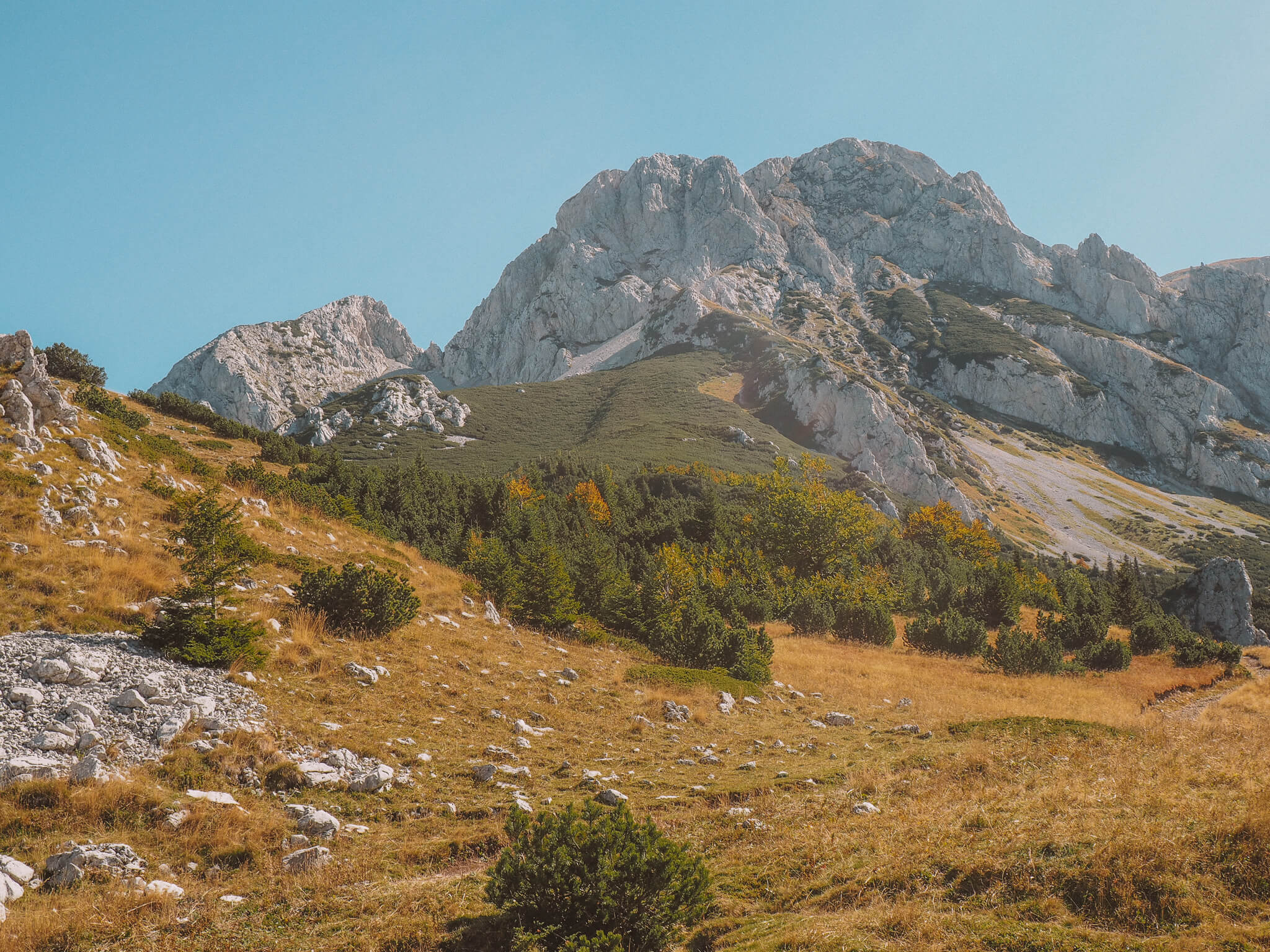
The best time of year for hiking in Sutjeska National Park
Spring | A great time to see nature blossom again and be one of the first on the trails. The national park can get a little more crowded around the Orthodox Easter holiday.
Summer | Hot and dry, this is the best time of year for hiking in and through the forest. You can expect to encounter lots of mosquitoes in the mountain meadows.
Autumn | An ideal time to visit the Sutjeska. Popular hikes are less crowded, the trees glow in the most beautiful colours and the temperatures during the day are often still pleasant.
Winter | Sutjeska is not particularly popular in winter. Many hiking trails are inaccessible due to the snow and can only be completed in the company of a trained guide. There are hardly any snowshoe tours on offer.
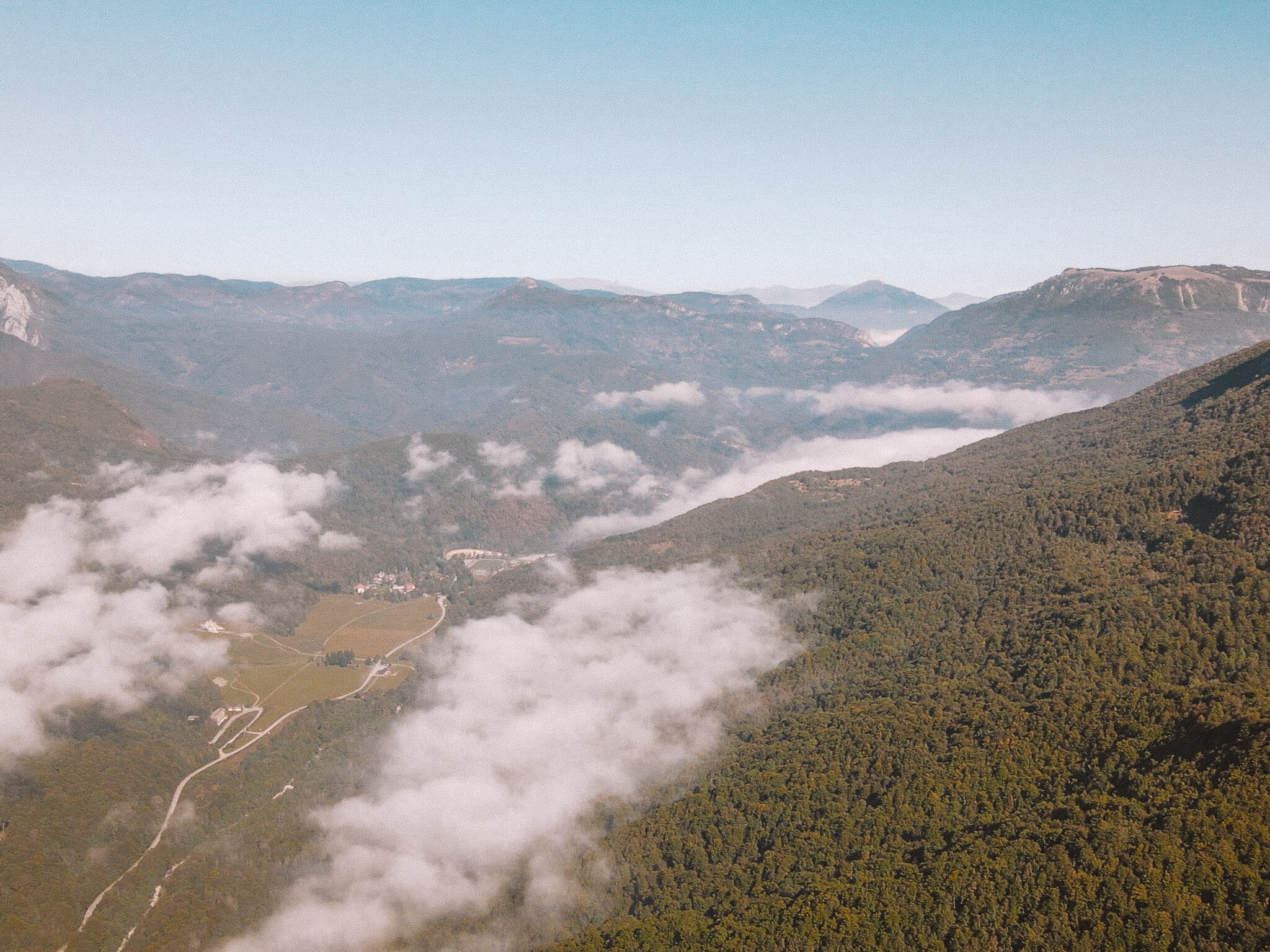
The most beautiful hikes in Sutjeska National Park
Hiking in the Perucica jungle to the Skakavac waterfall
Perućica is one of the last remaining primeval forests in Europe and is a UNESCO World Heritage Site - it was declared the strictest nature conservation zone back in 1952.
The most popular hike leads to the Skakavac waterfall. You can already spot it from the Dragoš Sedlo viewpoint - Densely wooded valleys stretch as far as the eye can see and a hundred metres below, the Skakavac waterfall shimmers, plunging 98 metres into the depths in the protected zone.
The way there is quite challenging: in less than four kilometres, it is 340 metres to the bottom of the jungle - and then the same way back again. There are no signposted hiking trails in Perućica, the forest is very dense and even impassable in some places. As the principle is not to interfere with nature, fallen trees are not removed from paths and new flora or fauna is not uprooted.
‼️ A note ‼️
Entering is only with guide and guide and with prior notification. There are hefty penalties for offences. Only 16 people per day are allowed in protection zone 1 directly by the waterfall.
Conversely, this means for you: You have the jungle pretty much to yourself, you can sit at the waterfall without large groups of travellers and simply enjoy yourself. And the hike with a guide guarantees exciting insights into the flora and fauna of one of the "lungs of Europe". A very special experience!
You can book a hike to the Skakavac waterfall here. A big recommendation for our hiking guide Dejan, who organised this hike like a safari and pointed out an uncanny number of animal tracks, events in the forest and the "life history" of the trees.
Details:
- Length: 3.9 km
- Difficulty: moderate to challenging
- Height difference: 350 m
What does that actually mean: primeval forest?
Around 6,000 years ago, Europe was a continent of primeval forests. Around 80 per cent of our continent was forested. Today, hardly any of it remains.
There are only a few so-called Primary and primeval forests. A forest is labelled as such if its life cycle and ecosystem have never been interfered with by humans.
Conversely, this means that even today, these forests must not be subject to any human intervention that has lasting consequences if they are to retain their status.
Many trees in the Perucica jungle are up to 300 years old and 50 metres high. A total of over 170 different tree and shrub species and over 1,000 other herbs and plants, many of which are endemic, grow in the Perucica, which is also home to bears, wolves and lynx.
You can read more about Europe's primeval and primary forests at WWF.
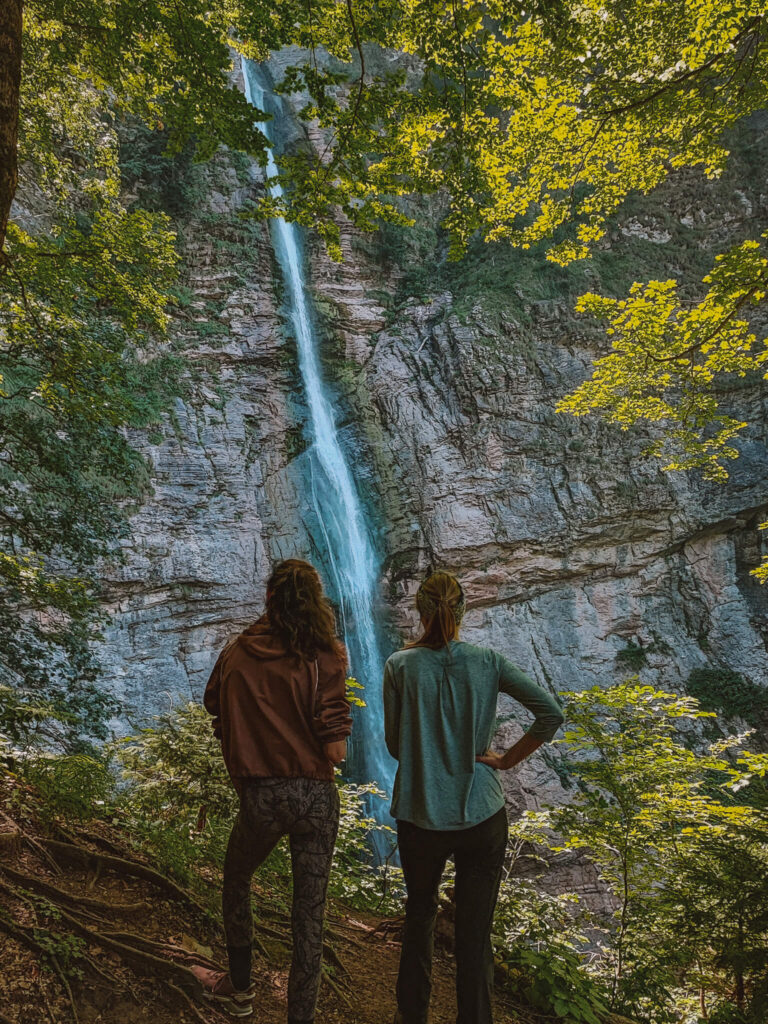
Hike to Trnovačko Jezero (in Montenegro)
Of all the hikes in Sutjeska, the one to Lake Trnovačko is certainly the most famous. And rightly so: it is one of the most beautiful hikes I have undertaken since living in Bosnia-Herzegovina. And how cool is it that you actually cross a national border on the hiking trail?
Trnovacko Jezero is technically not located in Sutjeska National Park, but in Piva National Park in Montenegro. You can of course reach the lake from Montenegro, but the route from Bosnia and Herzegovina is also a popular hiking route.
The first stage of this rewarding hike takes you from the Prijevor viewpoint, the starting point and car park, directly into the shadow of Bosnia's highest peak, the Maglić. The route continues along scree fields, with rugged karst ridges to the left and right, down to a beautiful meadow surrounded by the high peaks of two national parks. The route then climbs steeply back up to the lake - the most challenging part of the route, which makes reaching your destination all the more rewarding!
‼️ A noteEntry to the lake costs one EUR, which you should have with you in cash. As you are also crossing a national border, you must have an identity document with you. You can find my full hiking report on Lake Trnovačko here.
Details:
- Length: 10.3 km
- Difficulty: moderate
- Height difference: 545 m
- Hiking map
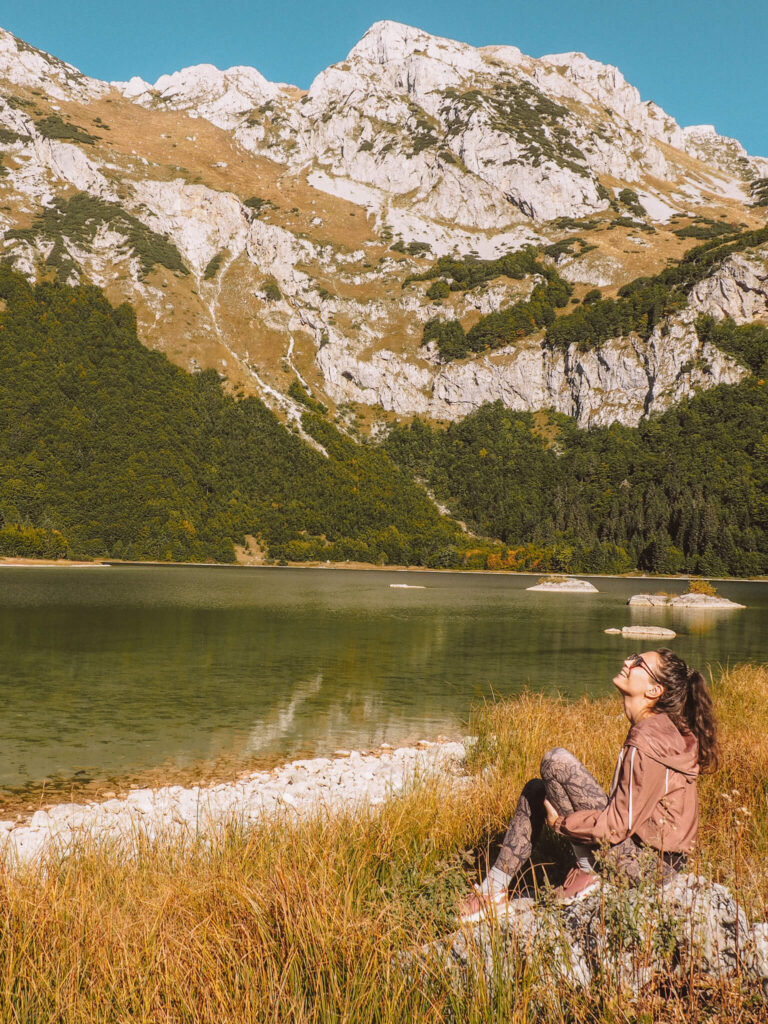

Hiking trip to the Gornje Bare and Donje Bare lakes
Completely unspoilt by human hands, Donje Bare Lake lies in a remote part of Mount Zelengora. A hike to these crystal-clear bathing lakes is a solitary pleasure. The journey alone is quite a challenge: it takes over an hour uphill on gravel tracks until we finally park at a small signpost.
Our hike - more of a walk - then takes us across mountain meadows strewn with blueberries to the lake (the second lake dried up at the end of the summer) at the foot of a scree field. A true paradise on earth - I have never seen such clear water, never felt such peaceful tranquillity anywhere. The only other people around are, with luck, a few mountain goats. The wild goats are at home on the slopes of the Zelengora.
In contrast to the barren plateaus of the Maglić, not only they, but also bears, deer and other forest animals find plenty of food here. Travelling with a well-trained guide is a clear advantage: they know the signs and tracks of the animals, whether one is nearby and how to behave. If you want to visit the Sutjeska, I really recommend that you do it with a mountain guide.
A hiking trip to Donje Bare can easily be combined with another stop at Donje Bare Lake. Today, there is a small hut here that offers a Spartan idyll - located on the shore of the lake and rented out by the mountaineering association. In the past, however, the Yugoslavian elite used to meet in Tito's villa on the shores of the crystal-clear lake, which appears almost transparent - today all that remains of it is a ruin.
Details:
- Length: 3.2 km
- Difficulty: easy
- Height difference: 110 m
- Hiking map


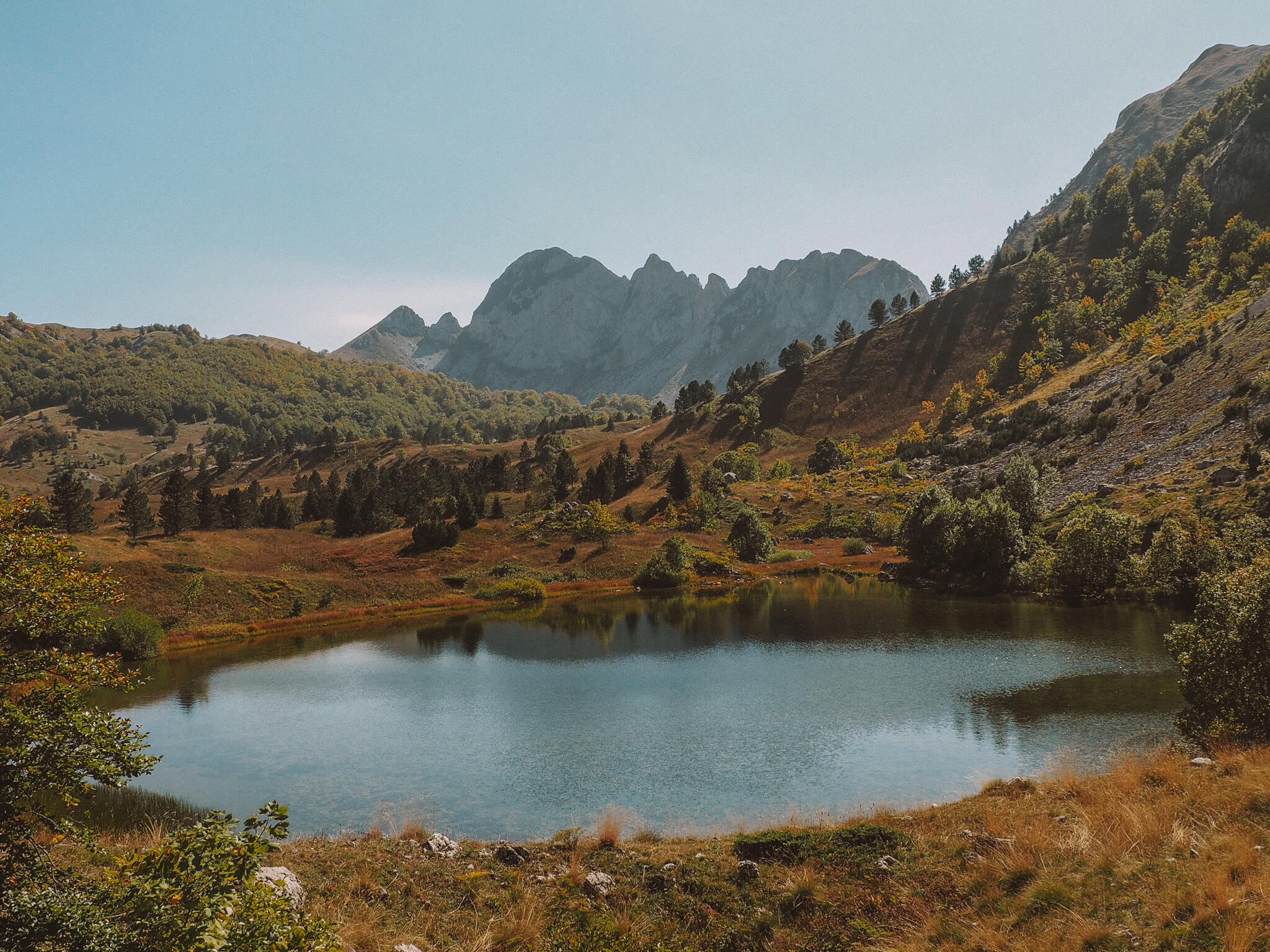
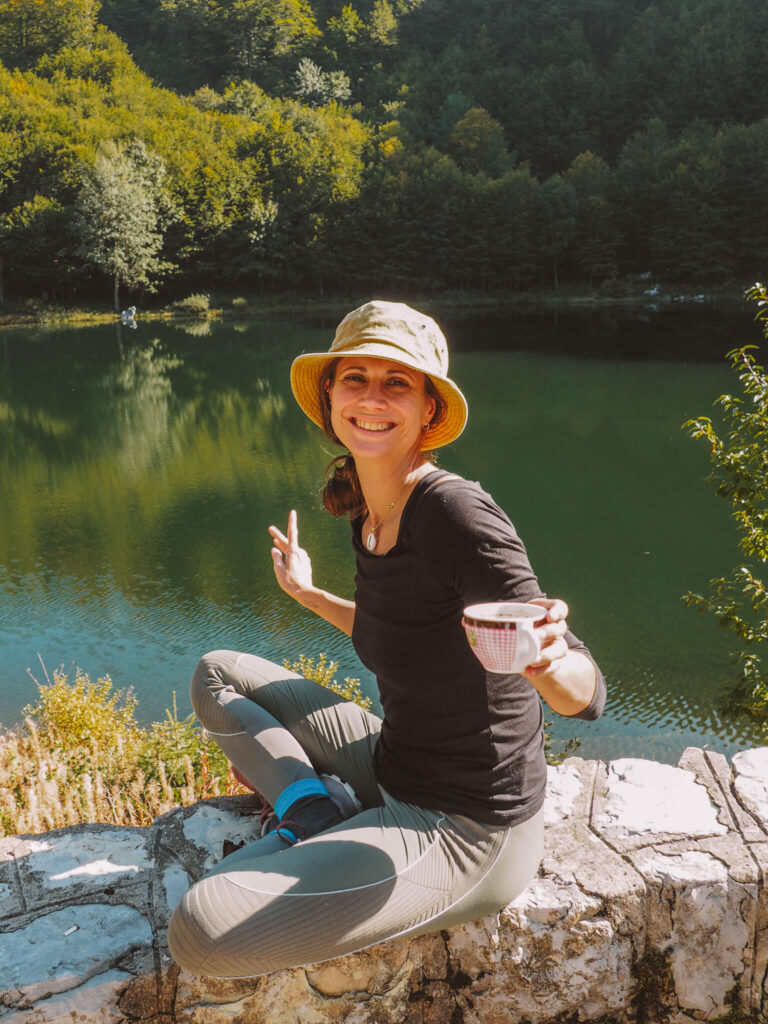

Ascent of the Maglić
The highest peak in the country is of course on the bucket list of many hikers, but should only be climbed by experienced hikers. The route is demanding and challenging, so good hiking equipment is a must!
Even in summer, the weather can change quickly. Maglić is also known as the misty mountain and once you have left the mountain meadows at its foot behind you, you climb over rugged karst fields to the summit. But the views during the climb are worth it! And at the end, of course - the sense of achievement awaits!
From Maglić, you not only have a view of the surrounding peaks, but Lake Trnovačko shimmers deep green and blue many hundreds of metres below. Visiting it on the way back is a good idea on this hike, as the route is considered the "easiest".
Details:
- Length: 12.6 km
- Difficulty: demanding
- Height difference: 1,109 m
- Hiking map
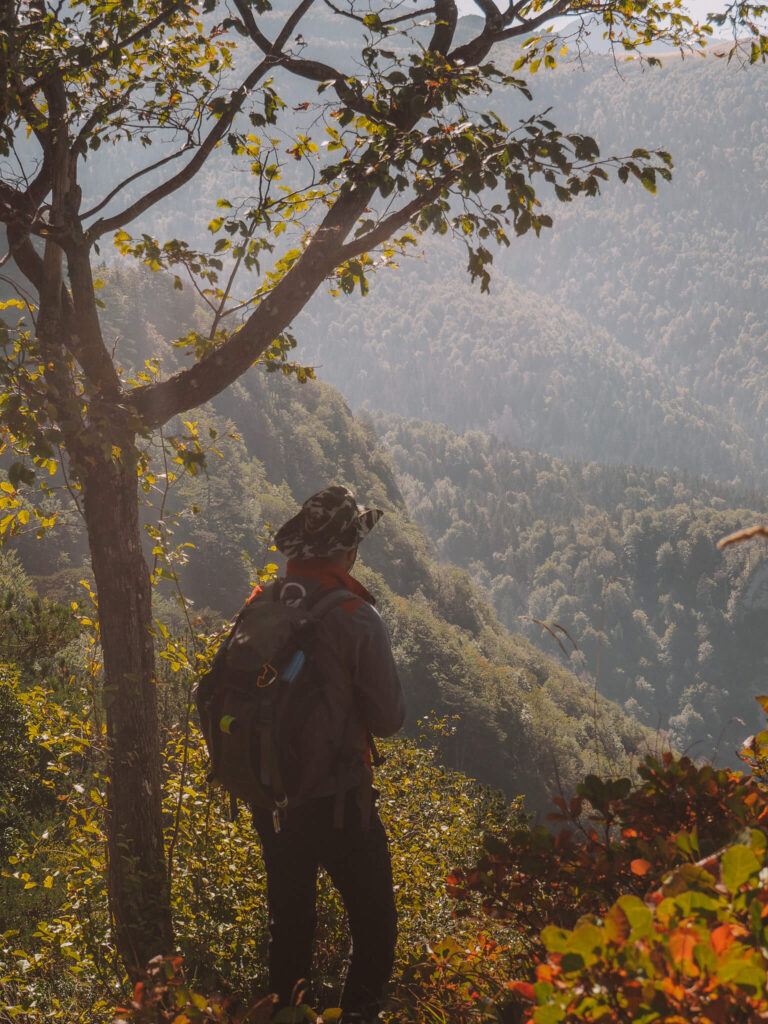
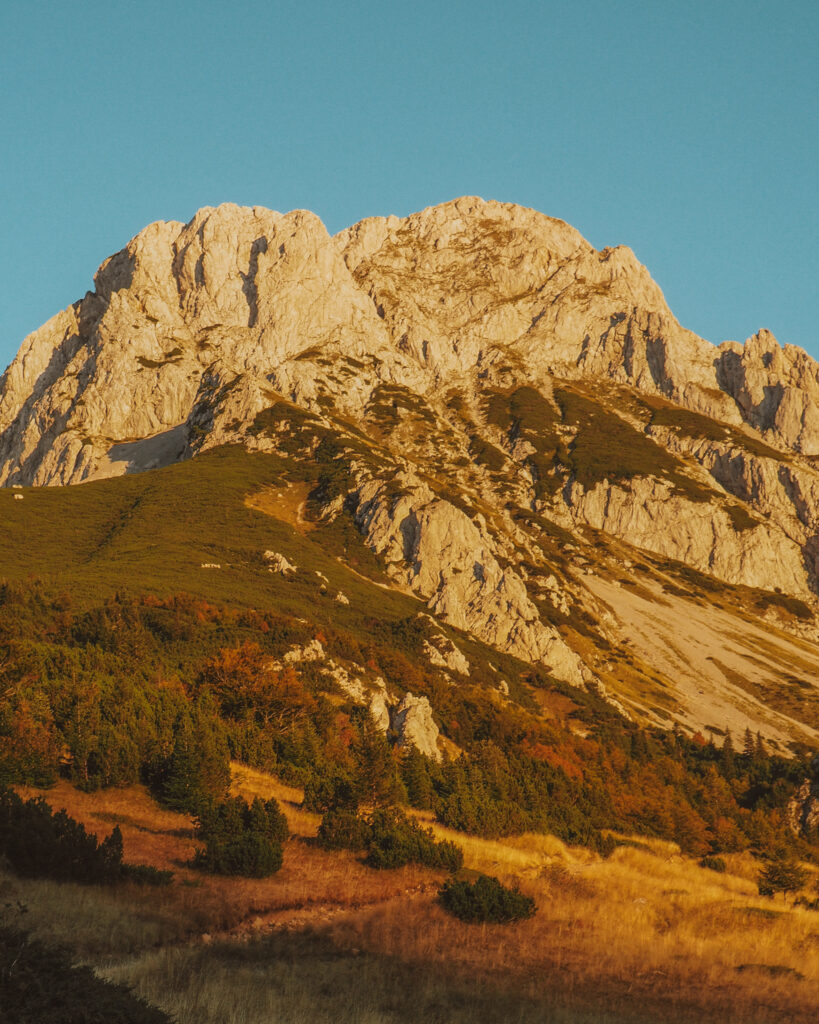
Overnight stays and accommodation in Sutjeska National Park
The village of Tjentište is the only one within the boundaries of the national park and also the place where you can stay. Unfortunately, the war destroyed tourism in many places in the country and even here in Sutjeska everything is not yet back to how it could be. As the national park is in state hands, modernisation is progressing slowly - while hiking trails are being better developed, there is still a lack of good and new accommodation.
One place to stay overnight is the Hotel Mladost - which was certainly all the rage in the 1970s, has now lost much of its glamour. But there is a hot shower, the beds are comfortable enough and the breakfast is fine.
From there, it is also just a few minutes' walk to the Tjentiste War Memorial, which was erected in honour of the Yugoslav partisans who fell in the Battle of Sutjeska during the Second World War. The partisan memorial is a very interesting architectural construction and is hard to miss.
The Komlen restaurant is also within walking distance - I would recommend having dinner here instead of at the Hotel Mladost.
The restaurant also rents out several Flat villaswhich are ideal for larger groups. Apart from the hotel, they are your only option for accommodation directly in the national park. The villas are spacious and one of them even has its own sauna!

Travel planning for Bosnia-Herzegovina made easy
💸 What is the currency of Bosnia and Herzegovina?
In Bosnia and Herzegovina, the convertible mark (KM for short) is used for payment. It has been the currency of Bosnia and Herzegovina since 22 June 1998 and was pegged to the German mark at a ratio of 1:1 until 2001 and to the euro since 2002. One euro is always exactly 1.95583 KM). The conversion is therefore very simple.
🇧🇦 What language is spoken in Bosnia and Herzegovina?
The official languages of the country are Bosnian, Serbian and Croatian, but there are hardly any linguistic differences between them - I always compare them to German and Austrian. Serbian, however, uses Cyrillic letters, which can lead to confusion in the Republika Srpska part of the country. The best thing to do is to download Google Translate, which also allows you to take photos of Cyrillic menus or street signs and have them translated.
💉 Do I need international health insurance for Bosnia and Herzegovina?
Absolutely! You should never, never, never travel without international health insurance. Bosnia and Herzegovina is also not in the EU, which means that your German health insurance covers the country. not with. I am always happy to recommend other travellers SafetyWing. For less than one euro per day, you can insure yourself here and also protect yourself against the risks of extreme sports, lost luggage and other travelling ailments.
📲 Can I use European roaming in Bosnia and Herzegovina?
No, as Bosnia and Herzegovina is not in the EU, your roaming package does not apply here. You can either buy a SIM card locally at a kiosk for a few marks or simply get an eSIM like Airalo, which you can even use for other countries after your trip to Bosnia. You can download the Airalo app here.
🪂 Which tour operator is recommended for my trip to Bosnia?
Together with my Bosnian partner, I founded the boutique travel agency .Cheyf in 2022. We have combined our experience of sustainable tourism in places like South Africa with our knowledge of Bosnia and the way of life in Bosnia. ćejf united - savouring the little moments that make life worth living. This has resulted in tours that convey sustainability, local experiences and communities and a real attitude to life. Here you can take a look at our tours and get to know Cheyf better.
🗺️ I would like to travel without a travel agency, are there any ready-made routes?
Yes! I offer an interactive travel map for the whole of Bosnia and Herzegovina, with several ready-made itineraries and lots of restaurants and insider tips. And best of all, the map is regularly updated and expanded, meaning you always have the latest recommendations in your pocket. Click here for the interactive travel guide.
💦 Can I drink the tap water in Bosnia and Herzegovina?
You can drink the water in large cities without hesitation. Bottled water is recommended after heavy rainfall or flooding and in rural areas.
🛬 Where can I find the best flights to Bosnia and Herzegovina?
You can find the cheapest flights on Kiwi - where you can compare prices directly.
🏯 Where can I find the best accommodation in Bosnia and Herzegovina?
Most accommodation in Bosnia and Herzegovina, including private accommodation, is often offered at Booking.com set. In addition to hotels, you can also book flats or guesthouses here and directly support the Bosnian population with your stay.
🛵 Where can I book a hire car for my trip to Bosnia?
On Rentalcars.com you can choose from a wide range of hire cars and compare prices. I recommend that you always book with fully comprehensive insurance. The German driving licence is valid, so you don't need to pack an international driving licence.
TRANSPARENCY: INVITATION & AFFILIATE LINKS
I was invited on the hikes to test them for my travel agency Cheyf and to include them in our offer. However, my opinion is unaffected by this - if I hadn't liked the excursions, they wouldn't have ended up on this blog or in my travel agency's offer.
This blog article also contains personal recommendations in the form of affiliate links. If you book or buy something via the links, I will receive a small commission. This does not change the price for you at all. Thank you for your support!
Have you ever been to Sutjeska National Park? If so, how did you like it? Do you have any additional tips and experiences? I look forward to reading about them in the comments!